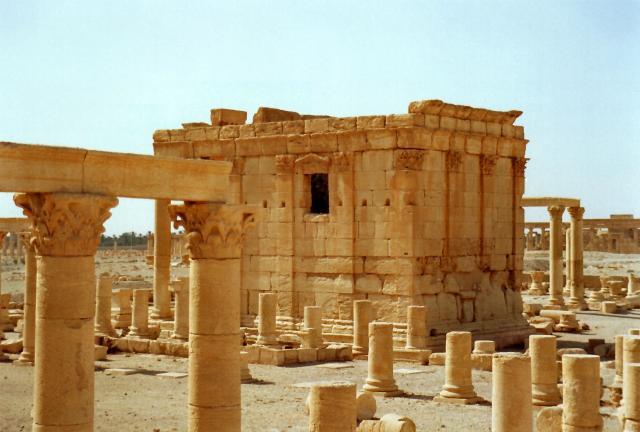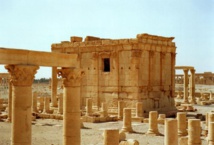Until Sunday, most of Palmyra's most famous sites had been left intact, though there were reports IS had mined them and the group reportedly destroyed a famous statue of a lion outside the city's museum.
"Daesh placed a large quantity of explosives in the temple of Baal Shamin today and then blew it up causing much damage to the temple," Syria's antiquities chief Maamoun Abdulkarim told AFP, using another name for IS.
"The cella (inner area of the temple) was destroyed and the columns around collapsed," he said.
The Syrian Observatory for Human Rights, a Britain-based group that monitors the country's civil war, confirmed the destruction of the temple.
IS, which controls swathes of Syria and neighbouring Iraq, captured Palmyra on May 21, sparking international concern about the fate of the heritage site described by UNESCO as of "outstanding universal value".
- 'Pearl of the desert' -
Baal Shamin was built in 17 AD and it was expanded under the reign of Roman emperor Hadrian in 130 AD.
Known as the "Pearl of the desert", Palmyra, which means City of Palms, is a well-preserved oasis 210 kilometres (130 miles) northeast of Damascus.
Its name first appeared on a tablet in the 19th century BC as a stopping point for caravans travelling on the Silk Road and between the Gulf and the Mediterranean.
But it was during the Roman Empire -- beginning in the first century BC and lasting another 400 years -- that Palmyra rose to prominence.
Before the arrival of Christianity in the second century, Palmyra worshipped the trinity of the Babylonian god Bel, as well Yarhibol (the sun) and Aglibol (the moon).
IS had mined the ancient site in June before destroying the Lion Statue of Athena -- a unique piece made of limestone that stood more than three metres high (10 feet) that stood outside a museum.
Funerary busts were also destroyed by IS in Palmyra.
Most of the pieces in the museum were evacuated by antiquities staff before IS arrived, though the group has blown up several historic Muslim graves.
IS's harsh version of Islam considers statues and grave markers to be idolatrous, and the group has destroyed antiquities and heritage sites in territory under its control in Syria and Iraq.
The latest developments come just days after IS jihadists beheaded the 82-year-old retired chief archaeologist of Palmyra.
IS has also executed hundreds of people in the city and surrounding area, many of them government employees, and infamously used child members to shoot dead 25 Syrian government soldiers in Palmyra's ancient amphitheatre.
"Our darkest predictions are unfortunately taking place," said Abdulkarim.
The jihadists "carried out executions in the ancient theatre (of Palmyra), they destroyed in July the famous Lion Statue of Athena... and transformed the museum into a prison and a courtroom."
---------------------------------------------------------------------------
"Daesh placed a large quantity of explosives in the temple of Baal Shamin today and then blew it up causing much damage to the temple," Syria's antiquities chief Maamoun Abdulkarim told AFP, using another name for IS.
"The cella (inner area of the temple) was destroyed and the columns around collapsed," he said.
The Syrian Observatory for Human Rights, a Britain-based group that monitors the country's civil war, confirmed the destruction of the temple.
IS, which controls swathes of Syria and neighbouring Iraq, captured Palmyra on May 21, sparking international concern about the fate of the heritage site described by UNESCO as of "outstanding universal value".
- 'Pearl of the desert' -
Baal Shamin was built in 17 AD and it was expanded under the reign of Roman emperor Hadrian in 130 AD.
Known as the "Pearl of the desert", Palmyra, which means City of Palms, is a well-preserved oasis 210 kilometres (130 miles) northeast of Damascus.
Its name first appeared on a tablet in the 19th century BC as a stopping point for caravans travelling on the Silk Road and between the Gulf and the Mediterranean.
But it was during the Roman Empire -- beginning in the first century BC and lasting another 400 years -- that Palmyra rose to prominence.
Before the arrival of Christianity in the second century, Palmyra worshipped the trinity of the Babylonian god Bel, as well Yarhibol (the sun) and Aglibol (the moon).
IS had mined the ancient site in June before destroying the Lion Statue of Athena -- a unique piece made of limestone that stood more than three metres high (10 feet) that stood outside a museum.
Funerary busts were also destroyed by IS in Palmyra.
Most of the pieces in the museum were evacuated by antiquities staff before IS arrived, though the group has blown up several historic Muslim graves.
IS's harsh version of Islam considers statues and grave markers to be idolatrous, and the group has destroyed antiquities and heritage sites in territory under its control in Syria and Iraq.
The latest developments come just days after IS jihadists beheaded the 82-year-old retired chief archaeologist of Palmyra.
IS has also executed hundreds of people in the city and surrounding area, many of them government employees, and infamously used child members to shoot dead 25 Syrian government soldiers in Palmyra's ancient amphitheatre.
"Our darkest predictions are unfortunately taking place," said Abdulkarim.
The jihadists "carried out executions in the ancient theatre (of Palmyra), they destroyed in July the famous Lion Statue of Athena... and transformed the museum into a prison and a courtroom."
---------------------------------------------------------------------------









 Home
Home Politics
Politics











